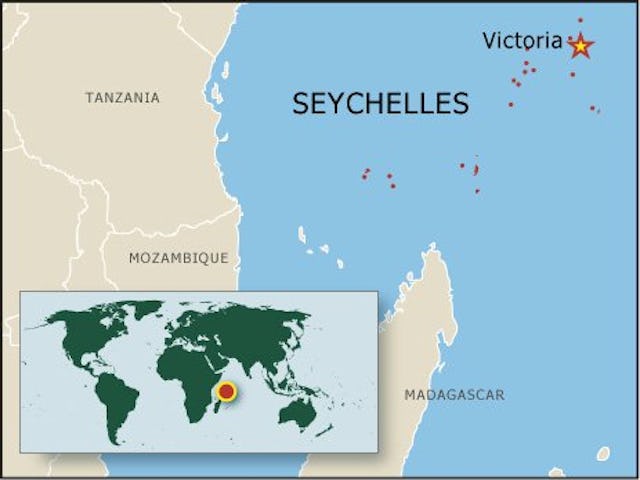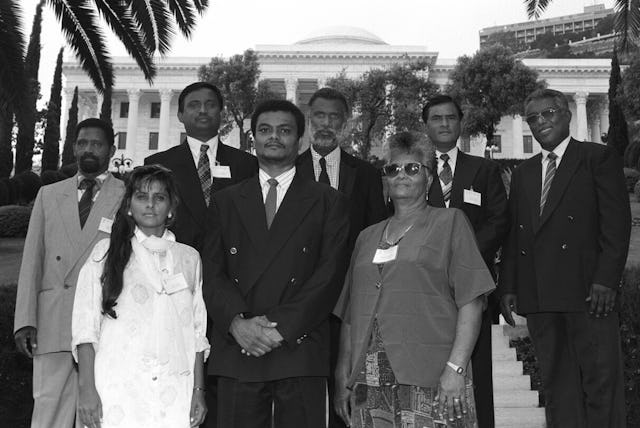Festivities exceed expectations at Seychelles celebration
VICTORIA, Seychelles — A jubilant Baha'i community celebrated its 50th anniversary here in a week-long series of events which included the official opening of an impressive new building as its center.
The prelude to the golden jubilee festivities was on 8 November 2003 as banners advertising the forthcoming official program were placed above all the main streets of the capital city.
Television coverage at prime time and extensive reporting on radio and in the newspapers informed the nation about what was to take place, but at that time nobody predicted the unprecedented public interest that was to come.
The first formal event was a workshop on virtues education in schools, and a presentation of books to the Ministry of Education sponsored by the National Spiritual Assembly of the Baha'is of Seychelles.
The response to the invitation to attend the workshop was overwhelming. More than 100 teachers from public and private schools attended. The media covered the event, and there were extensive inquiries from those in the public who wanted to obtain a publication on virtues for their own use.
Speaking at that event on behalf of the National Spiritual Assembly, Sarah Rene, who is a member of the Assembly and also the First Lady of Seychelles, said "educational systems must provide a more balanced education to our young souls, an education where the moral, ethical, and spiritual is given its due importance on a par with the intellectual and academic."
In response, the Minister of Education, Danny Faure, agreed that there was an urgent need to make the classroom curriculum more balanced. Mr. Faure also thanked the Baha'i community for its gift of books, and twice quoted what he described as a very profound statement by Baha'u'llah: "The earth is but one country, and mankind its citizens."
The next day saw the official dedication ceremony in Victoria of the new national Baha'i center, an event attended by some 400 guests, including the President of the Republic, France Albert Rene, along with the vice-president, a former president, the leader of the opposition, and many other ministers and high ranking officials.
Also present were Baha'i guests from India, Mauritius, the Maldives, the United Kingdom, and Nigeria. The national Baha'i choir provided uplifting music for the occasion.
Speeches by the chairman of the National Spiritual Assembly, Antonio Gopal, and vice-chairman Selwyn Gendron, explained much about the Baha'i Faith and its history in Seychelles.
"May this building," said Dr. Gendron, "provide the Baha'i community with a daily reminder that we need to strive for perfection in all aspects or our daily lives by adhering to the principles of our Faith."
"The Baha'i community of Seychelles is jubilant today to offer to our country what we believe to be a monument, and which we are sure will add to the richness of the architectural landscape of Seychelles," Dr. Gendron said.
Participating was one of the Baha'i community's historic figures, Munirih Zarqani, one of the first Baha'is to pioneer to the Seychelles and the widow of Abdu'l Rahman Zarqani, who was one of the two men named by Shoghi Effendi as a Knight of Baha'u'llah for bringing the Faith to the islands in January 1954.
Mrs. Zarqani unveiled the commemorative plaque with Dr. Badi Abbas, the son of the other Knight of Baha'u'llah, the late Kamil Abbas, who arrived in Seychelles from Iraq in November 1953.
Also present was the center's architect, Kamal Zarqani, the only son of Mr. and Mrs. Zarqani. Mrs. Rene, a daughter of the Zarqanis, also attended.
In his design concept, which integrated Baha'i concepts with the local culture, he combined ancient Greek architecture on the ground floor with traditional Seychelles architecture on the upper floor.
After the unveiling of the plaque, there was a two-hour pageant that depicted the history of the Baha'i Faith in Seychelles and an overview of the Revelation of Baha'u'llah.
Some 100 performers in the pageant and the background crew presented a show of songs, video, dances and skits. So much interest was generated in the pageant that it was staged again the following day, and another four days later, both times to full houses.
National television also broadcast the complete two hours 15 minutes of the pageant at prime time.
The next stage of the festivities involved two open days at the Baha'i center where members of the public were guided throughout. They visited an exhibition and watched video programs. They also bought many books and posed questions to the Baha'is about their Faith.
Two well-attended devotional programs were held, and many of the visiting public also registered to join Baha'i study circles.
Dr. Gendron later addressed a public meeting on the topic "Station and Teachings of Baha'u'llah."
The final event of the jubilee celebrations was the laying of the foundation stone of the Baha'i Centre of La Digue, the fourth biggest island of Seychelles, by a local Baha'i, Angela Sophola, and Mrs. Zarqani. Some 100 Baha'is as well as many local dignitaries attended the ceremony.
The national Baha'i choir sang, prayers were said, and Mr. Gopal addressed the gathering. National television news covered the event.
History of the community
Participants at the jubilee events heard about the first Baha'i to set foot in Seychelles, Mr. Abbas. Although he had to leave after five weeks, he taught the Faith to a local teacher, Marshall Delcy, the first Seychellois to become a Baha'i.
Shortly after Mr. Abbas left, Mr. Zarqani (1926-1994) arrived from India where he had been the secretary of the National Spiritual Assembly. Answering the call of Shoghi Effendi for Baha'is to take the teachings of Baha'u'llah throughout the world, he traveled with great courage to Seychelles, having heard it was a place of exile and having been warned, mistakenly, that there were cannibals there. He had originally intended to settle in the Chagos Islands.
However, when he landed he found Seychelles an exquisitely beautiful location and soon called for his young wife and daughter.
In mid-1954, Manuchihr Ma'ani Entessari arrived from Iran as a Baha'i pioneer bound for the Chagos archipelago. In 1955, Munir Wakil arrived from Iraq. He was joined by his family in 1956 and purchased land that is now the site of the national Baha'i center.
When Mr. Wakil arrived, the fact there were now nine adult Baha'i meant that they were able to elect the first Local Spiritual Assembly. The election was carried out in the house of a local Baha'i family, the Deweas. Five of the nine members were locals. Seychelles now has 13 Local Spiritual Assemblies.
During the 1960s, the Baha'i community inaugurated the observance in their country of international days celebrating Human Rights, the United Nations, Race Unity, World Peace, and World Religion.
Many people, including religious and civil leaders, attended those celebrations organized by the Baha'is.
In 1969, programs about the Faith were broadcast on national radio, the first religion to do so.

